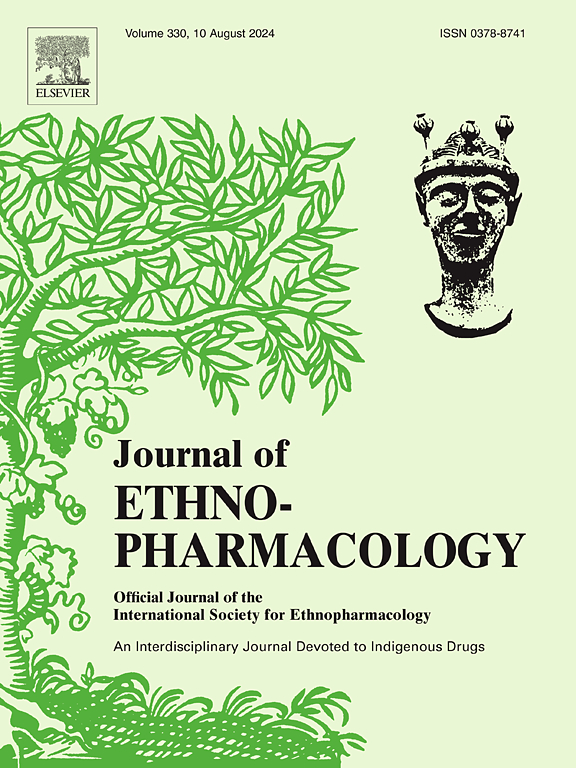Lancao decoction alleviates Alzheimer’s disease: Depending on activating CaMKII to protect neuronal refunction by reducing β-amyloid in the hippocampus
IF 4.8
2区 医学
Q1 CHEMISTRY, MEDICINAL
引用次数: 0
Abstract
Ethnopharmacological relevancy
Lancao decoction (LC) is a traditional Chinese medicine (TCM) formulation mentioned in the "Huangdineijing”, known for its ability to dispel turbidity and eliminate heat. TCM believes that the etiology of Alzheimer’s disease (AD) is phlegm turbidity, and the fiery internal obstruction of the gods, which suggests that LC has the possibility of treating.
Aim of the study
This investigation will examine the possibilities of LC to improve AD and uncover the underlying mechanisms.
Materials and methods
Gas chromatography (GC) and HPLC-MS were used to identify the content of the primary elements in LC and test the stability of its extraction. The function of LC in ameliorating AD was characterized by utilizing behavioral assessments such as the Morris water maze (MWM) and the Y-maze in AD modeling mice. Levels of molecular signaling and neurogenesis within the hippocampus was assessed using Western blot and immunostaining. Pharmacological interventions were used to explore the association of specific targets with neurogenesis and synaptic proteins and their contributions in LC improvement of AD.
Results
The main components of LC include p-Cymene, 3-Methoxy-p-cymene, neryl acetate, gallic acid, protocatechuic acid and euparin. APP/PS1 mice displayed behavioral characteristics indicative of memory and learning deficits, such as a notably longer time taken to reach the platform and reduced time spent in the area without the platform in the Morris Water Maze (MWM), as well as a longer delay in exploring the new arm and less time spent in the new arm in the Y-maze, when compared to C57BL6/J mice. However, these impairments were alleviated by chronic treatment with either LC or donepezil (DON) over a period of 14 days. Additionally, the phosphorylated levels of CaMKII and the amounts of synaptic proteins (synapsin1 and PSD95) were greatly diminished within the hippocampal region of APP/PS1 mice, which were also reversed by LC or DON. In addition, Aβ area was obviously increased in the hippocampus of the APP/PS1 murine model, which was also reversed by LC or DON. Inhibition of CaMKII activities not only blunted LC’s therapeutic actions of AD, but also blocked the enhancements of LC on synaptic proteins in the hippocampus, the quantity of cells that are co-stained with BrdU and DCX, and Ki67-positive cells located in the dentate gyrus (DG) of the hippocampus.
Conclusion
The results indicated that LC activated CaMKII to relieve Aβ formation, thereby enhancing neuronal functions in the hippocampus, and thus alleviated AD, which provided a theoretical basis for a deeper understanding of the mechanism, clinical application, and subsequent research of LC in alleviating AD.

求助全文
约1分钟内获得全文
求助全文
来源期刊

Journal of ethnopharmacology
医学-全科医学与补充医学
CiteScore
10.30
自引率
5.60%
发文量
967
审稿时长
77 days
期刊介绍:
The Journal of Ethnopharmacology is dedicated to the exchange of information and understandings about people''s use of plants, fungi, animals, microorganisms and minerals and their biological and pharmacological effects based on the principles established through international conventions. Early people confronted with illness and disease, discovered a wealth of useful therapeutic agents in the plant and animal kingdoms. The empirical knowledge of these medicinal substances and their toxic potential was passed on by oral tradition and sometimes recorded in herbals and other texts on materia medica. Many valuable drugs of today (e.g., atropine, ephedrine, tubocurarine, digoxin, reserpine) came into use through the study of indigenous remedies. Chemists continue to use plant-derived drugs (e.g., morphine, taxol, physostigmine, quinidine, emetine) as prototypes in their attempts to develop more effective and less toxic medicinals.
 求助内容:
求助内容: 应助结果提醒方式:
应助结果提醒方式:


